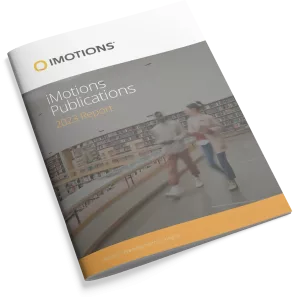-
Visual Attention Mechanisms in Happiness vs. Trustworthiness Processing of Facial Expressions
Abstract: A happy facial expression makes a person look (more) trustworthy. Do perceptions of happiness and trustworthiness rely on the same face regions and visual attention processes? In an eye-tracking study, eye movements and fixations were recorded while participants judged the un/happiness or the un/trustworthiness of dynamic facial expressions in which the eyes and/or the […]
-
How Does Food Taste in Anorexia and Bulimia Nervosa? A Protocol for a Quasi-Experimental, Cross-Sectional Design to Investigate Taste Aversion or Increased Hedonic Valence of Food in Eating Disorders
Background: Despite on-going efforts to better understand dysregulated eating, the olfactory-gustatory deficits and food preferences in eating disorders (ED), and the mechanisms underlying the perception of and responses to food properties in anorexia nervosa (AN) and bulimia nervosa (BN) remain largely unknown; both during the course of the illness and compared to healthy populations. It is, […]
-
Clinicians’ gaze behaviour in simulated paediatric emergencies
Aim: Differences in the gaze behaviour of experts and novices are described in aviation and surgery. This study sought to describe the gaze behaviour of clinicians from different training backgrounds during a simulated paediatric emergency. Methods: Clinicians from four clinical areas undertook a simulated emergency. Participants wore SMI (SensoMotoric Instruments) eye tracking glasses. We measured the fixation […]
-
Optimization of menu-labeling formats to drive healthy dining: An eye tracking study
Abstract: This study examines customers’ visual attention when choosing food and beverage items of a fast-food menu. Three formats on menu labeling were examined, including numeric, color-coded, and physical activity-based formats. An experimental choice paradigm combined with eye tracking technology explored customers’ visual attention, preferences for format, and menu choices. The study revealed that customers […]
-
Psychopathic Men: Deficits in General Mental Ability, Not Emotion Perception
Abstract: Psychopathy is characteristically associated with deficits in emotion perception; however, findings surrounding this deficit are actually quite mixed. This is most likely due to limitations of study methodology, including the use of tasks with unknown or poor psychometric properties, underpowered samples, and a lack of control for third variables. We present a study that […]
-
Consumer Evaluation of Hotel Service Robots
Abstract: In light of the trend in integrating artificial intelligence and robotics into tourism and hospitality operations, it is important to understand consumer responses to hotel service robots. Two studies were conducted to achieve this objective: an online survey and a laboratory experiment using measurements of automatic emotional reactions via biosensors. Responses to two types […]
-
Self-control: Knowledge or perishable resource?
Abstract: The self-control literature suggests two main short-run models with contradictory predictions. By perceiving self-control as a knowledge or perishable resource, those models report a positive and negative impact, respectively, of an initial self-control act on subsequent self-control ability. Using biometric data to monitor compliance enabled us to develop a unified self-control model, reconciling the […]
-
Unsold is unseen … or is it? Examining the role of peripheral vision in the consumer choice process using eye-tracking methodology
In visual marketing, the truism that “unseen is unsold” means that products that are not noticed will not be sold. This truism rests on the idea that the consumer choice process is heavily influenced by visual search. However, given that the majority of available products are not seen by consumers, this article examines the role […]
-
Identifying correlation between facial expression and heart rate and skin conductance with iMotions biometric platform
Abstract: Emotional reactions are stimulated when humans are presented with a stimulus, triggering a series of voluntary and involuntary responses. Human emotions can be measured from facial expressions and physiological processes. The iMotions biometric platform can detect and analyze the responses of different individuals, which are personalized. The iMotions software allows for the quantification of seven […]
-
Reducing Brain Signal Noise in the Prediction of Economic Choices: A Case Study in Neuroeconomics
Abstract: In order to reduce the noise of brain signals, neuroeconomic experiments typically aggregate data from hundreds of trials collected from a few individuals. This contrasts with the principle of simple and controlled designs in experimental and behavioral economics. We use a frequency domain variant of the stationary subspace analysis (SSA) technique, denoted as DSSA, […]
Research Report 2023
In-depth look at the scientific landscape as powered by iMotions software, showcasing groundbreaking research and the impact of our tools in various scientific and industrial fields.

Share Your Research

850+ universities worldwide with an iMotions human behavior lab
73 of the top 100 highest ranked universities
710+ published research papers using iMotions
iMotions is used for some of the most interesting human behavior research studies carried out by top researchers around the world. Contact us to have your publication featured here.
The authors of these publications have used iMotions as a software tool within their research.
“Software should be cited on the same basis as any other research product such as a paper or a book; that is, authors should cite the appropriate set of software products just as they cite the appropriate set of papers” (Katz et al., 2020).
We therefore encourage you to cite the use of iMotions where appropriate.
How to cite iMotions
APA
iMotions (10), iMotions A/S, Copenhagen, Denmark, (2024).
Note: adjust the version and year where relevant.
5 Most Popular Blogs
Learn How to Conduct Human Behavior Research with iMotions
Publications
Read publications made possible with iMotions
Blog
Get inspired and learn more from our expert content writers
Newsletter
A monthly close up of latest product and research news





